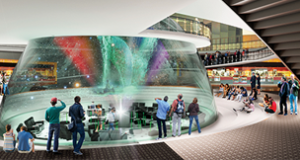An article by Sr. Principal, Jack Muffoletto, was featured in September issue of FilmJournal magazine, titled ” Shaping the Industry with Design: Amenities, technology, threats and consolidation influence the new theatre environment”.
In it Jack discussed how do we, the designers, address the key topics that influence the cinema industry. Jacks mentions consolidation, content release issues, technology and amenities among other major topics that have a deep impact on the theatre industry today.
For more details, please follow the following link to FilmJournal web version of the article: http://www.filmjournal.com/features/shaping-industry-design-amenities-technology-threats-and-consolidation-influence-new

If you want to get someone’s attention, talk about one of these topics that are influencing the cinema industry:
- Seating, self-service, more service, efficiency, “integrated” and “experiential” are the terms and amenities operators are contemplating today.
- I am continually fascinated by the pace of technology solutions entering the industry and the opportunities they create. If you don’t have technology or it is unavailable or slow, the customer quickly grows impatient and might have to wait or rely on others; this is a pain point to avoid.
- For years, industry leaders have contemplated the release window, piracy, VOD and alternative online entertainment options. Customers are truly moving from bricks to clicks, and this is a real threat. However, touch, feel, taste and special events are impossible to achieve online.
- Consolidation is eye-popping and more than likely will continue and create demand for more differentiation and innovation.
As cinema designers, these are the things we think about every day and we work to make the appropriate adjustments to stay ahead of the curve.
Our clients are asking for more from the design. The design must provide a destination that is not contrived and creates a desire to stay. How does the design increase the property value? How does the finished product differentiate one from the competition and other threats?
To me, it is about value and balance. Not everything is supposed to be a showplace. Designers should use restraint. There are times and opportunities for highlighting and there are times where you must take your personal emotions out of the equation in favor of practical tactics.
Design success is not just beautiful; it is budget-minded, considers the guest, and is durable. Subway tile has been used for 100 years and still works. Real wood has been around since trees. Once your durable finishes are in place, consider the incorporation of the feature design elements where you will spend money. Or think of elements that can be switched out or that are digital to be able to continuously change content. Spend money where the guest sees it: countertops, bars, concessions, entries, tables, toilet rooms, etc.—not a chandelier up high or a nondescript background. Don’t forget that accessibility is essential and required. But it does not need to be obtrusive. Layer in all of the priorities and filter that with the design.
Everybody is looking to maximize their bottom line, while at the same time customer expectations are rising. This can be used to your advantage. The recipe is to spend smarter and more creatively, and generate revenue streams. Just look at shifts in spending patterns to identify the trends: luxury, comfort, F&B. Also note that the customer is focused on differentiation: What is the latest food concept? What is the hottest fashion idea? What is the newest activity?
A way to start to address current guest expectations is to create active public space. The space needs to be functional but should be part of a broader story that is experiential, and has touch points that are revenue generators. Active social spaces are a huge selling point. Activate all space where there can be a revenue-generating opportunity or amenity. Creative food and beverage is getting a lot of attention as well as digital advertising, merchandise, interactive display, etc. Research indicates that Millennials and Centennials seek social-bonding experiences. They are informed consumers that expect engagement and participation.
You cannot hide from social media. And because of this, our clients are listening to the customer both at their own properties and the properties of their competitors. What they are hearing is that guests want more amenities. VIP is one of those value concepts, but it needs to be more than just high-end, bespoke design, fine details, etc. It has to be an immersive experience like no other, with service, technology, hospitality, food and beverage, art, relaxation, etc. It must have features for personal indulgence and be hyper-convenient. Customers will pay more for more value.
Grand lobbies and the open space of yesterday are now impractical uses of real estate. Instead, insert an active bar for customer engagement before and after the movie. A bar can increase the energy of your facility. Create a mood with controllable lighting and music. Create different zones with varying energy levels. Customers are drawn to the energy. Encompass a majority of the lobby, making a variety of “sellable” seating. The bar functions as the social center and is the leading element. Consider developing the lobby around the bar. Evoke communal gathering rather than a concession queue. Incorporate technology and furniture options. Use lighting to accentuate key elements like wall textures, artwork and the bottle display.
Architects provide solutions and help companies succeed. There is a business behind good design. It is capturing the essence of each client’s creative and financial vision and providing solutions that make good business sense. Renovation, for example, is pouring new life into established properties that have held stories for many of the guests. By repositioning your property, you will have guests telling their stories to a whole new generation.
Design is a team sport where the architect and the client determine where everybody fits in the lineup. Being highly collaborative is necessary because with knowledge-sharing comes innovation. Dare to think differently, taking risks, and discover surprising new solutions to old problems. Create a unique experience that happens only in your location.
The cinema operator must make the connection to the customer by being fresh, relevant, and experiential. Design is the platform to create this. Owners are allocating a lot of resources in their projects to contend with the competition and other entertainment option threats. Good design has a good business success rate. Architecture matters. Interior design matters.
Founded in 1981, TK Architects is a full-service architectural firm that offers all professional design services in-house to simplify and streamline coordination, including: Architecture, Interior Design, Graphic Design, Structural Engineering, Mechanical, Electrical and Plumbing Engineering. The firm’s focus is entertainment architecture and engineering, including cinema, bowling, bars/lounges, food service and entertainment centers worldwide. TK Architects provides the right services at the right time to meet client’s specific needs, including: New Buildings, Tenant Interiors, Renovations, Facility Upgrades and Maintenance.
For more information about TK Architects please visit www.tkarch.com or contact Jack C. Muffoletto, at jcmuffoletto@tkarch.com



